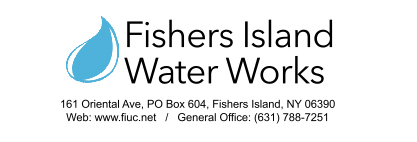Sharing the Cost to Renovate Our Island Water Distribution Network

February 21, 2020
The Water Company is planning a major renovation of the water distribution system on Fishers Island. This multi-year, multi-million-dollar infrastructure project has to be undertaken given the age and condition of the island’s network of cast iron water mains, many of which date back to the early 1900s.
This article is an overview of the investment required for this project, plans for financing that investment and the Company’s review of its rate structure.*
Project investment and borrowing. Based on preliminary estimates, the investment required for the renovation will be substantial. For example, the cost of detailed engineering plans for a network of replacement water mains is estimated at over $1.0 million. Phase 1 of actual construction, a new trunk main running west from the wells at Middle Farms to the intersection of Montauk and Oriental Avenues, is estimated at around $4.0 million.
The Water Company expects to finance the renovation by borrowing. It plans to do so in several tranches of loans over a period of years as the design and construction phases progress. In parallel stages, the Company will have to increase its revenues in order to finance the borrowing costs, mainly interest and principal payments, over the life of the loans.
The Fair Allocation Issue. Given the size of the impending financing costs for the renovation, the Water Company is considering whether its rate structure allocates the costs of the water system fairly between water customers, who benefit from potable water services, and property owners, who benefit from the fire protection infrastructure.
This allocation issue was debated in many water districts during the 20th century as water systems originally built exclusively for potable water were made more robust for fire protection or, conversely, systems built for fire protection were adapted to add potable water services. While charging customers based on water consumption is fairly straightforward, charging for fire protection infrastructure that is used sporadically in emergencies is less so. That infrastructure includes hydrants, standby water reservoirs for surges in water demand during a fire, supplemental high lift pressure pumps, and over-sized water mains to deliver higher volumes of water than needed for potable water services.
In the end, the water industry developed an allocation formula, now widely accepted, for estimating a water utility’s costs that are fire-related based on fire demand vs total utility demand for water. Applying the industry formula to Fishers Island, 70% of the Water Company’s revenue would come from water customers. The remaining 30% would come from property owners via property taxes allocated to the Fire District, which leases the fire protection infrastructure from the Water Company.
The Company’s current revenue split between these two sources is 93% from water customers and 7% from property owners via the fire infrastructure lease. In effect, according to the industry formula, water customers are providing a 23% subsidy to property owners for fire protection infrastructure. Year-round water customers pay a disproportionate amount of this subsidy.
The Goal. The Water Company has not made a final determination on how to change its rate structure to ensure that it has funds when needed to finance each phase of the distribution system renovation. The goal will be to raise Company revenues, in stages over time, in a way that spreads the costs the entire water system more in line with industry standards. The process will involve migrating the rate structure by weighting rate increases more toward property owners.
This could mean, for example, increasing incrementally charges to the Fire District under its infrastructure lease, leading to increases in property taxes to fund the resulting increases in the District’s annual budgets. However, the Fire District faces other budget considerations, such as financing a proposed firehouse renovation and housing a paid professional.
In any case, the Water Company is continuing its discussions with independent professional advisors, the Public Service Commission and the Fire District as a matter of priority given the critical nature of the renovation project. Fishers Island is not alone. Fresh water for daily use and water at high pressure from neighborhood hydrants have been taken for granted in water districts across the United States for decades. But water main networks over 100 years old are now in many ways obsolete. Across the country, water districts are facing this issue and an estimated $1 trillion of renovation costs.
The good news is that, by spreading the financing costs over time and across water customers and property owners, the community can support the renovation. Moreover, with modern materials and engineering, renovated water distribution infrastructure is highly cost-effective: it is easy to maintain, reliable and can serve for another 100 years.
Tom Siebens, Director
Fishers Island Water Works Corporation
*This is the second in a series of articles about the renovation of the water distribution infrastructure on Fishers Island. See “Renovating the Island’s Water Distribution System”, January 27, 2020, posted on www.FishersIsland.net and included in the February 2020 Fog Horn e-newsletter.
Posted in: Bulletin Board, eFogHorn, Featured, FI News, Sustainability, Utility Co
Leave a Comment (0) →